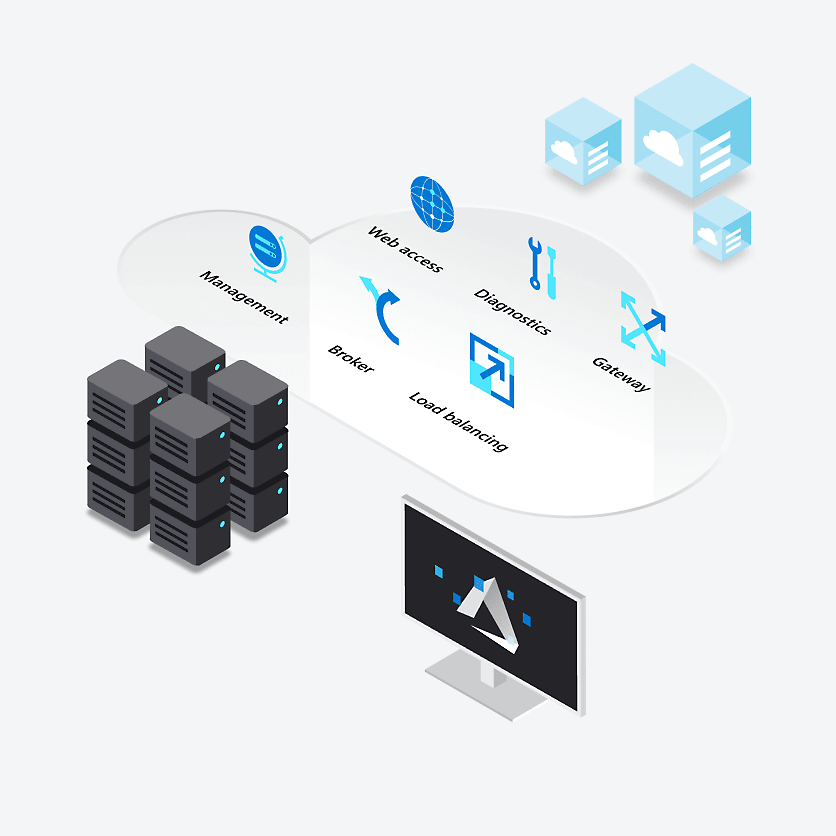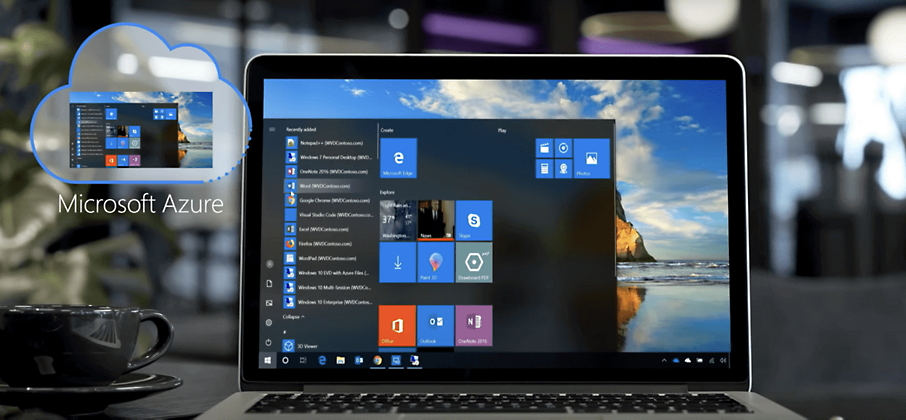What is virtual desktop infrastructure (VDI)?
The basics of remote desktops and virtualization.
What is virtualization?
In cloud computing, the process of separating software (such as an operating system or an application) from the hardware that it runs on is called virtualization. This frees the software from needing to be run on a specific device—and allows it to be run on any device. For most people, the most familiar usage of virtualization is when they access a remote version of their work desktop on a personal device, but IT professionals also use it for virtual computers, virtual applications, storage, networks, and servers. Virtualization has been around for years but is enjoying a boom due to the worldwide demand for IT infrastructure with virtualization solutions to enable highly secure remote work from anywhere in the world.
So, virtualization is the process—and the "machines" created using this process are called virtual machines, or just VMs for short. While the hardware that makes up your computer is physical and tangible, VMs are virtual computers that exist as code and whose "hardware" (CPU, hard drive, RAM, etc.) are defined using software. VMs can be used for a myriad of applications—they're especially useful for running the virtual desktop environments that are becoming the norm in our rapidly evolving modern workplace.
To be clear, the hardware behind VMs is very real! It's just that while a traditional computer has its own dedicated hardware, a VM is partitioned portions of a real physical server's resources so that multiple, independent VMs can share the same physical hardware. This process is also known as server virtualization and uses a nifty technology called a hypervisor, which is software that integrates the physical hardware and the VM's virtual "hardware". This allows IT pros to set up and manage VMs and allows VMs running different operating systems (such as Windows or Linux, to name a few) to run on the same hardware.

What is virtual desktop infrastructure?
Virtual desktop infrastructure, often shortened to just VDI, is IT infrastructure that lets you access enterprise computer systems from almost any device (such as your personal computer, smartphone, or tablet), eliminating the need for your company to provide you with—and manage, repair, and replace—a physical machine. Authorized users can access the same company servers, files, apps, and services from any approved device through a secure desktop client or browser.
VDI lets you run traditional desktop workloads on centralized servers and has become the standard in business settings to support remote and branch office workers and provide access to contractors and partners. VDI helps protect sensitive company apps and data (which can themselves be run from highly secure datacenters), allowing users to use their own devices without worrying about mixing personal data with corporate assets.
There are multiple ways to deliver virtual desktops and apps to users—virtual desktop infrastructure to be sure but additionally other flavors of VDI such as desktop as a service (DaaS) and even personalized Cloud PCs. These services have become increasingly popular for a variety of reasons—including improved security, performance, centralization, lower hardware requirements, and cost savings—not to mention enabling employees to do their jobs from anywhere in the world.
How does VDI work?
Because VDI is supported by extensive collections of VMs running on top of hypervisor software, VDI environments can get more complex than remote desktop environments. VDI uses server hardware to run desktop operating systems (OS) like Windows or Linux, or other software programs, on a VM with the desktop OS hosted on a centralized server in a physical datacenter.
Cloud providers typically offer two types of virtual desktops—persistent and nonpersistent—each with advantages for different use cases.
A persistent virtual desktop is a good option for users such as developers and IT professionals—providing the necessary persistent environment for users that require elevated permissions. Because they offer the greatest degree of personalization and app compatibility, persistent virtual desktops usually come at a higher cost per user than the nonpersistent types.
A nonpersistent virtual desktop offers a level of personalization, but it separates the personalization layer from the underlying OS. This allows any user to sign in to any VM and get a personalized experience, but the personalization will not “persist” and is removed once the user signs out. Nonpersistent desktops offer a lower cost solution per user and are a good option for knowledge and task workers in environments such as computer labs, call centers, or retail kiosks.
What is VDI used for?
With the global changes in work patterns, more companies are embracing VDI. Here are just some of the use cases:
Empowering remote work
An increasing number of companies are implementing VDI for remote workers because virtual desktops are easier to deploy and update from a centralized location.
Enabling task-based or shift work
Organizations such as call centers or public computer labs that have a large number of users who need the same software to perform limited tasks find nonpersistent VDI to be particularly well suited to their use case.
Meeting security and compliance requirements
VDI services can help keep apps and data secure and compliant with intelligent security capabilities that can proactively detect threats and take remedial action.
Allowing users to bring their own devices (BYOD)
Since processing is done on a centralized server, VDI is an ideal solution for organizations with BYOD policies as it allows the use of a wider range of devices. It also helps with data security because data lives on the server and is kept off the client devices.
What are the benefits of virtualization with VDI?
In the past, many businesses running on legacy IT systems thought the cost and the high-performance requirements of VDI deployment were too challenging to consider for their company. However, thanks to the emergence of converged and hyperconverged infrastructure (HCI) systems for virtual desktop infrastructure, these obstacles have been largely overcome and many more companies are taking advantage of the scalability, reliability, and cost savings that are offered when VDI is hosted by a cloud provider.

Tangible benefits of VDI include:
-
Remote access, productivity, and device portability: Workers who are frequently mobile or out in the field can pull up a virtual desktop containing the full range of virtual apps and data—like having a mobile office available on-demand. With VDI technology, the desktop is not chained to the hardware; you can view your desktop from multiple devices—whether mobile, laptops, tablets, or thin client devices.
-
Enhanced security: Because VDI is centralized and sandboxed, it can be a foundational component of a company’s security strategy. It eliminates the IT headache of having sensitive company data stored locally on client devices. And it keeps personal apps and info separate from enterprise apps, helping to protect both sides.
-
Improved compliance: VDI often offers organizations help with compliance certifications, particularly in certain verticals like government or finance services where there’s a need to host and process data to align with federal regulations or for business that operate in Europe where they need to make sure they comply with GDPR regulations when dealing with personal data.
-
IT cost savings and lower hardware requirements— Because VDI processing is largely server-based, there’s no need for expensive or cutting-edge hardware. VDI can also save costs on licensing, other IT infrastructure, hardware refresh deployment, and maintenance, as well as saving investment costs on company-issued devices.
-
Datacenter features and capabilities— Companies can take advantage of the features and functionalities of desktops hosted on servers in high-performance datacenters when they run their VDI through a cloud service provider. Many trusted cloud providers offer advanced security, high-end infrastructure, cloud backup and disaster recovery solutions.
-
Simplified IT management and easy desktop provisioning—VDI eliminates the need to configure each system manually, making it easy to provision desktops almost instantaneously. This lets IT admins configure their network settings, add users, run desktop apps, and turn on security from a central location with a few clicks.
Access your desktop and apps from anywhere
Learn how to enable a secure, remote desktop experience with Azure Virtual Desktop (formerly Windows Virtual Desktop).

Frequently asked questions
-
A hypervisor is software that integrates the physical hardware and the virtual "hardware" of virtual machines (VMs). Much like a school crossing guard helps multiple students move safely back and forth across a busy intersection, the hypervisor makes sure each VM gets allocated the resources it needs from the physical server. in an efficient manner.
-
With "service" right in the name, many cloud providers offer desktop as a service (sometimes made into the acronym, DaaS)—a flavor of VDI service for virtual hosting the back end of VDI deployment. DaaS provides similar advantages to VDI, including enabling remote work, improved security, and ease of desktop management. Additionally, DaaS can give big cost savings upfront because DaaS doesn’t require the same initial investment in compute, storage, and network infrastructure that VDI does.
-
While it may seem like all these virtualization terms are just moving the word order around, there is a difference between a remote desktop environment and a virtual desktop infrastructure! Virtualizing desktops and application virtualization are generic computing terms for any technology that separates a desktop environment from the physical hardware used to access that desktop.
VDI is one popular type of desktop virtualization, but not all types of virtualization take advantage of host-based virtual machines like VDI does. Desktop virtualization can be used in other ways, such as remote desktop services (RDS)—where users connect to a shared desktop that runs on a remote server. So, when we say remote desktop, we’re really talking about a software or operating system feature that allows a computer's desktop environment to be run remotely on one system while being displayed on a separate client device.
-
Virtual desktop infrastructure allows for remote app streaming— to run your apps on the host server and stream them to remote devices. Remote app streaming lets you create a low-latency, high-performance user experience from virtually anywhere, on any device.
-
Remote Desktop Services (RDS) is a platform offering from Microsoft that allows you to cost-effectively host Windows desktops and apps. RDS creates different server roles and each specific role enables multiple users to simultaneously login to a Windows Server. Once set up, you can connect to the published desktops and apps from various platforms and devices—using the Microsoft Remote Desktop application on Windows, Mac, iOS, and Android.
-
Remote Desktop Protocol (RDP) is a Microsoft protocol that helps app developers simplify the complexities of dealing with the protocol stack. It helps developers to write clean, well-designed, well-behaved 32-bit apps and it facilitates security, data transfer, and encryption between devices, client users, and a virtual server.
-
This is the foundational category of cloud computing services. Renting infrastructure—servers and virtual machines (VMs), storage, networks, and operating systems—on a pay-as-you-go basis from a cloud service provider like Microsoft Azure lets you save on upfront costs of infrastructure investment. In other words, adopting IaaS allows you to leave behind the more rigid and expensive traditional CAPEX model for your IT investments in favor of a more flexible, scalable, and affordable OPEX model.
Resources and solutions
Azure Virtual Desktop
Enable a highly secure, remote desktop experience from virtually anywhere on any device.
VMware Horizon Cloud on Microsoft Azure
A VMware service that simplifies the delivery of virtual desktops and apps on Azure by extending Windows Virtual Desktop.
Citrix Virtual Apps and Desktops for Azure
A service from Citrix that simplifies the delivery of virtual desktops and apps on Azure by extending Windows Virtual Desktop.
Free Account
Try Azure cloud computing services free for up to 30 days.
Pay as you go
Get started with pay-as-you-go pricing. There's no upfront commitment—cancel anytime.
